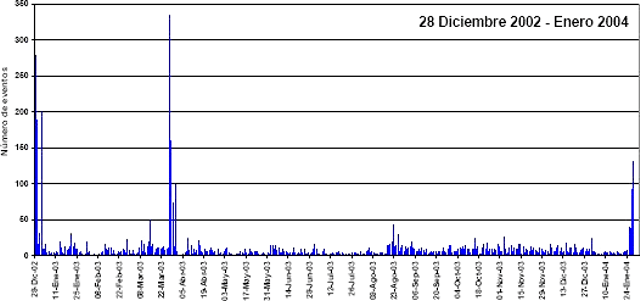Report on Cayambe (Ecuador) — November 2006
Bulletin of the Global Volcanism Network, vol. 31, no. 11 (November 2006)
Managing Editor: Richard Wunderman.
Cayambe (Ecuador) Seismic swarms occur erratically in 2004 and 2005
Please cite this report as:
Global Volcanism Program, 2006. Report on Cayambe (Ecuador) (Wunderman, R., ed.). Bulletin of the Global Volcanism Network, 31:11. Smithsonian Institution. https://doi.org/10.5479/si.GVP.BGVN200611-352006
Cayambe
Ecuador
0.029°N, 77.986°W; summit elev. 5790 m
All times are local (unless otherwise noted)
During 2004, Cayambe's seismicity increased three times, on 25-31 January, on 25 February-5 March, and on 4-12 October. Our previous report on Cayambe discussed events through November 2003 (BGVN 28:11).
The first seismic swarm began on 25 January 2004 when the number of volcano-tectonic (VT) earthquakes increased, with seismic activity occurring in bands lasting 2-3 hours. The events were small in magnitude and were located ~ 1-4 km below the SW flank. At 1934 on 27 January, a magnitude 3.4 earthquake was recorded. On 29 January, the activity peaked with 148 earthquakes reported. Seismicity thereafter decreased to normal base-line levels.
The second earthquake swarm began on 25 February with an increased number of VT earthquakes. Like the January events, these earthquakes were of low magnitude. The largest event occurred on 29 February at 1059 measuring M 3.1. The events were localized primarily below the E flank with peak activity on 2 March, when 271 earthquakes were registered. The energy released by this cluster was far larger than the one in January and was almost comparable to activity in March 2003 (figure 2).
On 12 March, a small increase in activity was recorded, and on the morning of 15 March, a M 3.6 earthquake was recorded on the S flank. Residents reported no felt earthquakes.
On 4 October, there was a slight increase in the number of events registered with a total of 18 events, 17 of which were hybrid events. At 2333 on 6 October a M 3.4 event was recorded. These earthquakes were located in the S zone of the volcano edifice. Two seismic swarms on 8 October consisted of 177 VT earthquakes. The first swarm registered at 0500 and lasted an hour. The second swarm began at 1130 and lasted approximately 9 hours. Some of these events were located in the SW flank. After the seismic anomalies on 4 and 6- 8 October, activity returned to normal base-line levels.
Apart from the swarms between September and October, the seismicity appears to have changed, with the number of VT events diminishing by one-half in relation to those previously recorded, whereas the number of hybrid events tripled. Later, long-period LP events were again observed, which is characteristic of this volcano returning to normal levels.
The internal seismic activity at Cayambe is characterized by the generation of 10 events per day on average. Nevertheless, this type of activity has alternated with sporadic seismic swarms consisting of hundreds of events lasting several days, after which activity returns to the base-line level. These types of seismic swarms were recorded in December 2002, March 2003, and in January, March, and October of 2004 (figure 3), with similar characteristics and averaging 2 days in duration. Scientists inferred the cause of the observed seismicity as related to motion of fluids in the interior of the edifice. Thermal images obtained during 2004 did not contain anomalies.
During 16-18 September 2005 a short seismic episode occurred with earthquakes on the SW flank, ranging from 135 to 330 events per day. The earthquakes reached a maximum magnitude of 3.6.
Geological Summary. The massive compound andesitic-dacitic Cayambe stratovolcano is located on the western edge of the Cordillera Real, east of the Inter-Andean Valley. The volcano, whose southern flank is on the equator, is capped by extensive glaciers. The modern Nevado Cayambe, constructed to the east of older Pleistocene volcanic complexes, contains two summit lava domes about 1.5 km apart. Several other lava domes on the upper flanks have been the source of pyroclastic flows that reached the lower flanks. A prominent Holocene pyroclastic cone on the lower E flank, La Virgen, fed thick andesitic lava flows that traveled about 10 km E. Nevado Cayambe has also produced frequent explosive eruptions beginning about 4,000 years ago, with the most recent known activity during 1785-86.
Information Contacts: Instituto Geofisico (IG), Escuela Politécnica Nacional, Apartado 17-01-2759, Quito, Ecuador (URL: http://www.igepn.edu.ec/).



